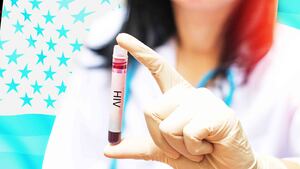One morning in late September, Tyomi Morgan was stressed. She’d just moved from New York to Chicago and was staying in her parents’ cramped home. As Morgan put it, she needed a “me day.” So the 31-year-old took off work to do some of her favorite things. She apartment-hunted, smoked some weed, went to a Thai restaurant for tom kha gai soup and drunken noodles, and went on a date. While she was at it, Morgan also got an STI test.
“It was my day to do whatever I wanted,” Morgan told The Daily Beast. “I like to make getting tested about me. It is a self journey. When I went to sleep that night, I felt so accomplished.”
Morgan is married, but non-monogamous, and gets tested about every two months. Every time she does, she pairs her screening with comforting activities like going to a movie, the spa, or just staying home to read, journal, and watch TV.
“Sitting in that waiting room with a bunch of other people going through the same thing, God, it’s a lot,” Morgan said. “Emotionally, I need to get myself back on track and take the time to get myself together. To jump back into regular life after a test, I don’t recommend it. There’s no way you can be around other people and really focus on living life when in the back of your mind, you’re wondering what the results could be.”
Screening for sexually transmitted infections has never been a fun experience. Millennials, often screaming about their burnout, might need a few perks to compel them to get tested, especially as rates of STIs continue to rise in the United States. Enter: the wellness industrial complex.
Last month, the University of Michigan hosted a daylong event with “well-being boosters and fall fun” for students, who could chase their free STI screening with wellness coaching. Loyola University Chicago offered a similar test-a-palooza, offering HIV swabs alongside a free massage, yoga practice, or reiki session. The Stonewall Center at the University of Massachusetts had a therapy dog and masseuse at their annual health fair last year.
Earlier this year, a clinic in Dublin offered a Groupon deal which promised a free glass of prosecco to anyone coming in for an STI screening.
Erica Smith worked as a sexuality educator at the Children’s Hospital of Philadelphia for 17 years, and part of her job included encouraging teenagers to know their status. “In my years working in adolescent care, we constantly used incentives to get them in the door,” Smith said. “We gave them gift cards to McDonalds or a free concert ticket with every HIV test. If they go and see it’s not a scary experience, or have a positive time with a clinician, they’re more likely to come back.”
“We wanted to make it a routine part of taking care of yourself,” Smith said. “Check your blood pressure, do your manicure, get an STI test. Social media and how we feel the need to perform a lot of our daily living for others has contributed to reducing the stigma about STIs and thinking about screenings as another form of self-care.”
With the rise of home-testing kits, those who don’t have an aversion to finger-pricking can slap on a face mask, turn up Gilmore Girls, and do their own check-up. “I’ve told people that [STI testing] is very boring self-care,” Emily Depasse, a sexologist, said. “It’s part of knowing yourself and your body, and finding alignment in that.”
A company recently sent Depasse a test to try at home, and she plans to do so on a Friday night. “I’ll pair it with watching Law and Order: SVU with my cat and chill in bed with a face mask,” Depasse said. “And I’ll talk about getting testing with my girlfriends and guy friends, the same way I would about my face mask and period. Especially if we’re already talking about who we’re sleeping with.”
Mail-in tests are growing in popularity and acceptance, and are seen as a more convenient way to get checked. But it’s still a relatively new offering, and one 2015 study found, perhaps unsurprisingly, that physicians still give the most accurate results and are less prone to false diagnoses than at-home options.
“While those tests do give access to folks who feel like going to clinics was a barrier, the drawback is it also removes the support you would get from a doctor or counselor if you get results from a physician,” Smith said. “With certain diagnosis, like HIV especially, having a person in front of you for support is hugely important, because of their immediate linkage to care.”
After one of Morgan’s check-ups last year, a doctor told her she had chlamydia, made more worrisome by the fact that she might have passed the infection to her husband. “I did take the day to relax,” she said. “My husband and I cuddled, we both took the medication at the same time, cheers-ed before we swallowed the pill.” They ordered her favorite comfort food, sticky wings from a local barbecue chain and cream peach Manischewitz.
“I’m pretty sure I was not hungry in the moment, but food makes everything better and so does wine,” Morgan said. “It should be celebrated when you discover you have something and you know it can be treated or cured.”
Ciarra Colvin, 31, lives in Philadelphia and has been HIV positive for over a decade. Before her diagnosis, Colvin did not get checked regularly. “My biggest concern at that age, my act of self-care, was birth control and not getting pregnant,” Colvin said. “HIV testing was part of the panel, so I thought, ‘Why not?’ When the test came back positive, it came from left field.”
Colvin now regularly gets tested for other STIs like herpes, hepatitis, and HPV. She thinks of her check-ups as self-care in the most literal sense. “If I don’t go to the doctor and make sure my medicine is working, I could not be here. I do it to stay alive.”
She has not coupled her screenings with a massage or facial, but after speaking with The Daily Beast, maybe she will next time.
“Hell yes I would,” Colvin said. “I mean, I think most of us would go for a massage before we would a screening.”







